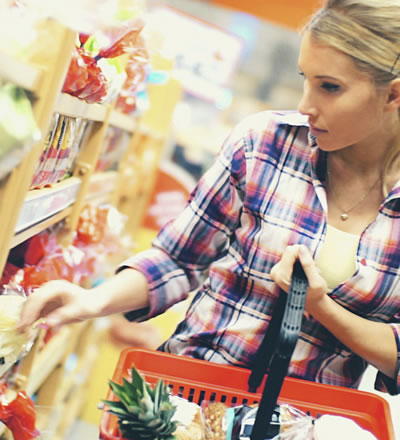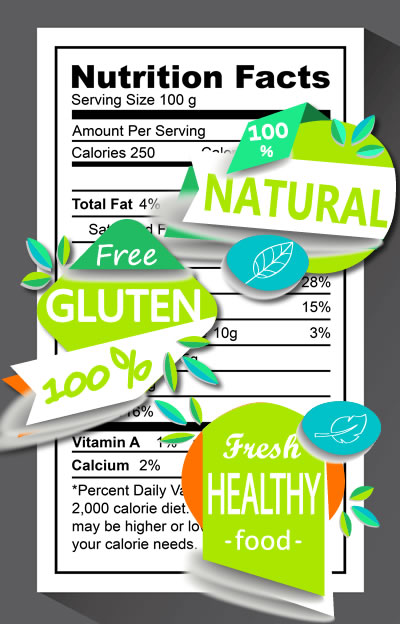Processed & Packaged Foods:
Separating the Good from the Bad
Once you’ve learned how to differentiate between minimally processed and heavily processed food products and read nutrition labels, you’ll be well on your way to a healthy eating plan.

Defining Processed Foods
There is often confusion between packaged and processed foods and sometimes, it's difficult to know what is actually healthy or not. Many products, such as candy, potato chips, fast food and microwave pizza are easily identifiable as bad, unhealthy foods that are known as the nation-wide cause of obesity. These processed foods are ones that have been refined, and are cautioned against in the Pritikin Diet and Eating Plan. Refined grains include white rice, white bread and white pastas while sugar, honey and corn syrup are all considered refined sugars. These Pritikin “caution” foods have been proven to increase the risk of not just obesity, but several other health concerns as well, including high cholesterol, high blood sugar, heart disease, diabetes, hypertension and even some cancers.

However, not all processed foods are necessarily bad. For example, bagged and frozen spinach and whole-wheat bread or foods packaged at their peak freshness such as canned beans and tomatoes are all considered processed, according to the Academy of Nutrition and Dietetics. The word processed is not exactly black and white and as such, food products fall on a scale of minimally to heavily processed. So while refined and heavily processed foods are poor choices for health, there are several benefits – such as convenience – to foods that are minimally processed.
Thus, the Pritikin Diet and Eating Plan focuses on whole, unprocessed foods, but also incorporates food products that are minimally processed. Products that are minimally processed are generally OK, though it is very important to look for hidden sugar, sodium and fat. Labels can also be deceiving when it comes to whole-wheat products, explained registered dietitian and Pritikin's Director of Nutrition Kimberly Gomer. It's important that the grain you are choosing to purchase is actually a whole grain. On the box, a large majority of pasta and bread products will say that they are whole-wheat. However, if the first ingredient is wheat flour, it's not actually what it claims to be: It is actually just refined flour. To ensure that you are getting whole grains, you want to be sure that whole-wheat flour or bran is on the ingredient list.
Reading Food Labels
Even once you understand the consequences of processed food, it's not always easy to say no to that packaged treat at the movie theater or to forego airplane snacks. The good news is that once you make the switch, each day gets easier, not harder. Eventually, you will get to a point where processed food no longer tastes good, a point that Kimberly likes to call the “ah-ha!” moment. Filling up on wholesome, natural foods and feeling great without being hungry is one of the milestones of Pritikin, she said.
Kimberly explained that the best way to remove processed foods from your diet starts with a little extra effort and planning. First and foremost, you must be able to read and understand food labels. Though the eye-catching front of the box may be telling you a certain food is a great choice, the ingredient list on the back will dictate otherwise. Don't fall for the marketing schemes on the front of the package that boast low-fat, light, fat-free or other benefits.
Label-reading is a key component of the Pritikin program. It's taught in the nutrition classes as its own lecture and then tested during fun exercises including identifying and filling grocery bags with healthy food. The importance of label-reading is reinforced for a final time during the popular grocery store scavenger hunt.
 Guests at the Pritikin Center learn to look past the marketing claims on the front of the box, and instead focus on the Nutrition Facts information. Knowing what to look for on a nutrition label is one of the first steps to healthy living.
Guests at the Pritikin Center learn to look past the marketing claims on the front of the box, and instead focus on the Nutrition Facts information. Knowing what to look for on a nutrition label is one of the first steps to healthy living.
Pritikin Salad Dressing
Traditional salad dressings sold at the supermarket and at restaurants may claim to be healthy, but the majority are loaded with shocking amounts of calories, sodium and even sugar. However, that doesn’t mean you have to cut out your go-to Asian salad dressing. Our chefs at Pritikin have bottled up their light and healthy homemade dressings for you to enjoy at home. At under 50 calories per serving, these dressings have just a fraction of the sodium of their counterparts and none of the saturated fat!Shop Salad Dressings
Pritikin Frozen Food
Just because you’ve left your stay at the Pritikin Longevity Center doesn’t mean you have to say goodbye to all of the delicious gourmet food hand-crafted by our talented chefs. In fact, enjoying healthy, Pritikin-approved food has never been easier. With Pritikin Frozen Foods, you can indulge in all of your Pritikin favorites, from dinners and lunches to soups and desserts. Simply head online and add your items to the cart and they will be delivered right to your door! You can even opt for an entire one- or two-week meal plan.
Shop Frozen Food